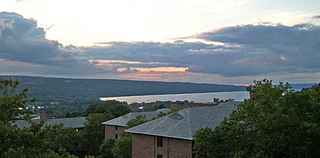
Cayuga Lake is the longest of central New York's glacial Finger Lakes, and is the second largest in surface area and second largest in volume. It is just under 39 miles (63 km) long. Its average width is 1.7 miles (2.8 km), and it is 3.5 mi wide (5.6 km) at its widest point, near Aurora. It is approximately 435 ft deep (133 m) at its deepest point, and has over 95 miles (153 km) of shoreline.

Ithaca is a city in and the county seat of Tompkins County, New York, United States. Situated on the southern shore of Cayuga Lake in the Finger Lakes region of New York, Ithaca is the largest community in the Ithaca metropolitan statistical area. It is named after the Greek island of Ithaca. As of 2020, the city's population was 32,108.

Tompkins County is a county located in the U.S. state of New York. As of the 2020 census, the population was 105,740. The county seat is Ithaca. The name is in honor of Daniel D. Tompkins, who served as Governor of New York and Vice President of the United States. The county is part of the Southern Tier region of the state.

Trumansburg is a village in Tompkins County, New York, United States. The population was 1,797 at the 2010 census. The name incorporates a misspelling of the surname of the founder, Abner Treman. The Tremans spelled their surname several different ways; "Truman," however, was not one of them. The village's application for a post office established the present spelling. The Village of Trumansburg is located within the Town of Ulysses and is northwest of Ithaca, New York.
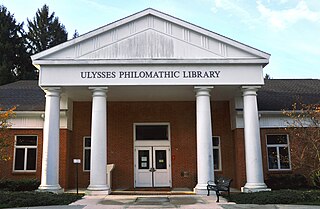
Ulysses is a town located in northwest Tompkins County, New York, U.S. The population was 4,940 at the 2020 census. The town was named after the hero of the Odyssey.

Hans Albrecht Bethe was a German-American theoretical physicist who made major contributions to nuclear physics, astrophysics, quantum electrodynamics, and solid-state physics, and who won the 1967 Nobel Prize in Physics for his work on the theory of stellar nucleosynthesis. For most of his career, Bethe was a professor at Cornell University.
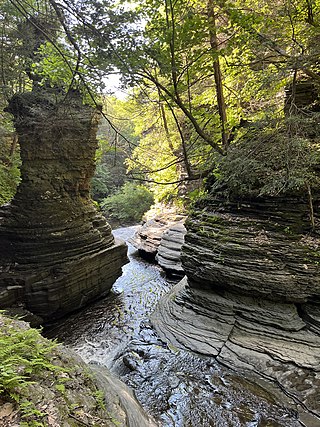
Buttermilk Falls State Park is a 811-acre (3.28 km2) state park located southwest of Ithaca, New York, United States. Like Robert H. Treman State Park, a portion of the land that was to become the state park came from Robert and Laura Treman in 1924.

Taughannock Falls State Park is a 750-acre (3.0 km2) state park located in the town of Ulysses in Tompkins County, New York in the United States. The park is northwest of Ithaca near Trumansburg.

The Cornell Botanic Gardens is a botanical garden located adjacent to the Cornell University campus in Ithaca, New York. The Botanic Gardens proper consist of 25 acres (10 ha) of botanical gardens and 150 acres (61 ha) of the F. R. Newman Arboretum. The greater Botanic Gardens includes 40 different nature areas around Cornell and Ithaca, covering 4,300 acres (1,700 ha).
This is a list of trails in Ithaca, New York.
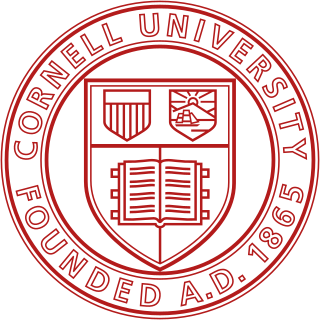
Cornell University is a private Ivy League land-grant research university based in Ithaca, New York. The university was founded in 1865 by Ezra Cornell and Andrew Dickson White. Since its founding, Cornell has been a co-educational and nonsectarian institution. As of fall 2023, the student body included over 16,000 undergraduate and 10,000 graduate students from all 50 U.S. states and 130 countries.
The Cornell University Department of History is an academic department in the College of Arts and Sciences at Cornell University that focuses on the study of history. Founded in 1868, it is one of Cornell's original departments and has been a center for the development of professional historical research institutions in the United States, including the American Historical Association and the American Historical Review. It remains a highly-ranked program in the field and its alumni and faculty have won Nobel and Pulitzer Prizes, among other distinctions. In addition, many of Cornell's presidents have served among its ranks.

Ithaca Falls is a waterfall located within the city of Ithaca, New York. It is the last of a series of waterfalls along the hanging valley formed where Fall Creek intersects the glacial trough of Cayuga Lake. The falls are in an amphitheater formed by freezing and thawing of the weak shale which makes up most of the gorge walls. The splash pool, and the creek just below the falls, are a popular spot for fly fishing.
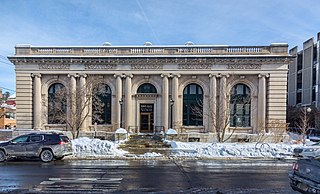
Ithaca is a town in Tompkins County, New York, United States. The town's population was 22,283 at the 2020 census. The town is in the central part of the county, in the Finger Lakes–Southern Tier region of New York, and is part of the Ithaca Metropolitan Statistical Area. The Town of Ithaca is a horseshoe-shaped portion of the metropolitan area of Ithaca, New York, surrounding the City of Ithaca and being the city's only border. Ithaca College is located in the South Hill section of the town.
Lansing is a village in Tompkins County, New York, United States, and a suburb of Ithaca. The population was 3,648 at the 2020 census.
Lansing is a town in Tompkins County, New York, United States. The population was 11,565 at the 2020 census.
The All Sports Championship is a collegiate intramural program at Cornell University culminating in the awarding of the All Sports Trophy. The competition is refereed over a series of sports competitions through the Fall and Spring Term. Each sports' competition ends in the awarding of a University Championship and points toward the All Sports Trophy.

The Cayuga and Susquehanna Railroad was a railroad in the state of New York, in the United States. Its line ran from Ithaca, New York, to Owego, New York. It was founded in 1829 and began operations in 1834. The Delaware, Lackawanna and Western Railroad (Lackawanna) leased the company in 1855, but it remained in existence as a non-operating subsidiary. It was conveyed to Conrail in the bankruptcy of the Erie Lackawanna Railway, successor to the Lackawanna, in 1976.
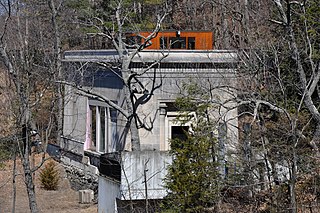
900 Stewart Avenue is a building in Ithaca, New York, noted for its Egyptian Revival architecture, its dramatic placement partway down a cliff, and being the residence of astronomer Carl Sagan. The building is on a ledge about 50 feet (15 m) below street level, overlooking Fall Creek and Ithaca Falls.















